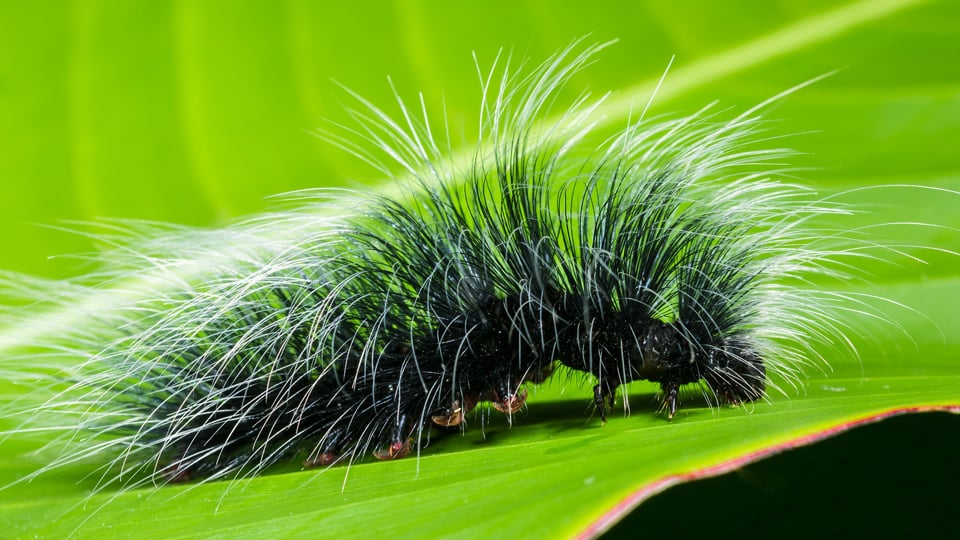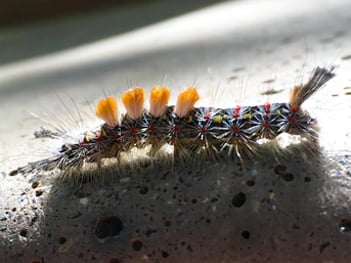Crazy Cool Caterpillars

Spring is here, which means caterpillars are starting to creep and crawl here at Kidspace! Caterpillars have an important job in the butterfly life cycle, to eat! And munch. And snack. And then eat some more.
While these lovely larvae stay focused on food, they need to be able to stay safe from other creatures that might want to eat them. But when your job is to eat, you can’t spend all day on the lookout for predators. So how do you stay safe?
Look closely, and you might be able to discover some answers!
We’re looking at you, larvae.

Wiki User: Hsuepfle
You can tell a lot about how a caterpillar might protect itself while it eats by looking closely at its morphology. Morphology is the form and structure of an animal’s body, and something we can explore with some careful observation using our eyes. Let’s take a look at a few caterpillars, and see what we can discover.
If you have adopted a caterpillar from Kidspace, see what you notice about it as we explore below!
What do you notice about its patterns and color?
Color and patterns can tell us a lot about how a caterpillar avoids predators. For example, let’s look at the Giant Swallowtail. What does this caterpillar look like to you? (Yes, it really is a caterpillar!)

Photo by Aaron Carlson
This caterpillar is using color and pattern to disguise itself as something else, in this case it mimics the look of a splat of bird poop. Would you want to take a bite? Other caterpillar disguises include markings like snakes, spiders, a pair of eyes, or looking like a plant.
A plant disguise is one way a caterpillar might blend in with its environment, but they also might use colors and patterns in a different way to camouflage. Take a look at this Cloudless Sulphur:

Wikipedia User: Umbris
While its bright yellow (and often green) striped body are not exactly a disguise, it does help it disappear into the yellow-flowered, green-stemmed senna plants that it likes to it eat.
Instead of blending in, colors and patterns might do the exact opposite, and make a caterpillar appear stand out in its environment. Here is a Gulf Fritillary caterpillar:

Flickr User: muscogeegirl
This caterpillar is using warning coloration to let potential predators know that they best stay away. For the Gulf Fritillary, its bright color not only warns predators that it tastes bad, but also that it is poisonous!
Fun fact! Some caterpillars that use chemical defenses retrieve the elements to do this from the plants that they eat. This ability can stay with the butterfly into adulthood, so it helps protect them as a caterpillar and as a butterfly. One of the most famous examples of this is the Monarch, which accumulates a poisonous cardenolides compound from its host plant, milkweed!
Do you see anything more about the Gulf Fritillary morphology that might help it stay safe?
Do you notice spines, spikes, or hairs?

Consider what might it be like if you were to pop this fellow in your mouth as a snack – ouch! Spines and hairs physically deter many predators as not a lot of creatures want a mouthful. While many, like our Painted Lady caterpillars, are not that hazardous (especially since we are not trying to eat them!) some caterpillars have particularly disagreeable defenses.
This punk rock caterpillar is a Tussok Moth. Its colorful mane is made up of urticating hairs. Urticating hairs irritate the skin of a predator, often causing itching and sometimes rashes. The Tussok Moths hairs do this because they have little barbs at the end that stick into the sensitive skin of a predator’s mouth and face.

Photo by Brett Hondow
Fun fact! Another arthropod that is well known for this morphological defense mechanism are tarantulas! They sometimes will even use their rear legs to kick the urticating hairs off their back to create a ‘cloud’ of hairs in the air around them when they feel threatened.
Some caterpillars, like Puss or Asp caterpillars, have urticating hairs that are particularly agonizing. They are connected to poison sacs and release a ‘sting’ when a predator touches them. Even though these caterpillars might look soft and cuddly, unless you are sure what kind of caterpillar it is, it’s best to observe them carefully from a distance!

Photo by Brenda Timmermans
What do you notice?
These are a few ways that caterpillars stay safe with morphology! Now that you know a little more about these adaptations, take a closer look at your caterpillar, and see if you can figure out how it might be using its body to stay safe.
Cool Resources
Want a hand identifying a caterpillar? Check out Caterpillar Identification.
Learn more on how Monarchs use cardenolides from milkweed here.
From March 15 – April 30, 2021 Kidspace will be celebrating its 25th Annual Butterfly Season! Adopt your own caterpillar friend from the Kidspace Store starting April 29.

